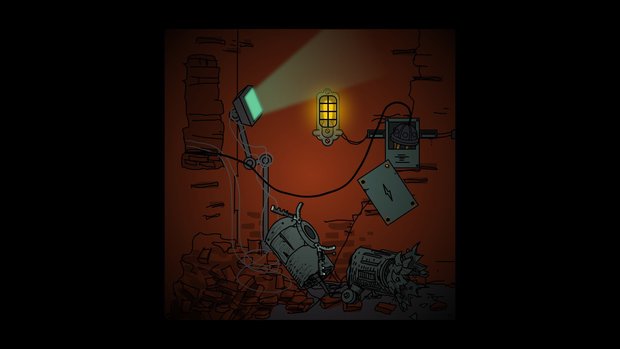Submachine: Legacy review

- 1 Comment
Mateusz Skutnik’s excellent Flash series re-emerges to live on in an enhanced, cohesive singular adventure
If the name Submachine conjures up fond memories for you—if you spent the decade between 2005 to 2015 spelunking through the subnet and trading theories while you waited for the latest installment of the original free Flash series—then you likely already know all you need to about Submachine: Legacy, the revamped and updated omnibus of designer Mateusz Skutnik’s semi-legendary trans-dimensional odyssey: that it unites the ten original chapters into a single cohesive package; that the graphics and puzzles have received a fresh coat of paint and quality-of-life tweaks; that this new and definitive presentation will allow Submachine to persist in a post-Flash world.
If none of that means anything to you, though, don’t worry: Legacy ought to be as accessible to newcomers as it is to die-hard, there-from-the-start devotees. Though the original is now almost twenty years old, Submachine: Legacy is no museum piece; it’s an astonishingly intricate and beautifully crafted journey into a strange and unexpected setting that shows almost none of its age. If you like your puzzles difficult, your obstacles frequent, and your narratives ambiguous, you’ll understand right away why it’s endured for so long.
The story begins with the (silent, nameless, faceless) player character stepping into an elevator that travels deep underground, letting out in the basement of a subterranean lighthouse. Your immediate goal, insofar as you have one, is just to explore and find out what makes the place tick. There are odd devices and mechanisms everywhere, and solving the complex puzzles of their function produces clues to a larger picture. Scattered about, you’ll find notes by a mysterious person (or persons), alluding to somebody named Murtaugh, formerly the lighthouse’s keeper. It seems Murtaugh made a shocking, paradigm-shifting discovery, the nature of which is initially unclear but which concerned an energy he dubbed karma.

Harnessing and manipulating karma allowed Murtaugh to enter the subnet: a vast, otherworldly network of buried mechanical structures—submachines, short for subterranean machines—linked together by portals of karma energy. Murtaugh became obsessed with exploring and mapping the subnet, and led numerous expeditions to that end. That was long ago now, though; his current whereabouts—along with those of his many team members—are unknown. While he and others can, at times, communicate directly with you—both by leaving notes and, occasionally, via computer terminals you stumble across—you appear separated by space, time, and other more mysterious factors. Eventually, of course, you’ll find your own way into the subnet, and it’s only by following in Murtaugh’s footsteps that you’ll have a hope of seeing the surface again.
As in the lighthouse, there are notes laying out scraps of Murtaugh’s story tucked away throughout the subnet. Many of these are entirely optional to collect, and easily missed if you don’t keep your eyes open. The more you read, the more familiar you’ll become with some of the subnet’s other (unseen) explorers—most notably Elizabeth, Murtaugh’s dearest friend and philosophical opposite who became entangled in his grand plans—but your progress is rarely dependent on how much you’ve pieced together about your predecessors. Either way, you’ll probably finish the game with plenty of questions left over; Submachine has had a very active community for almost twenty years, and they’re still posting theories about what it all means.
With narrative taking a backseat, the game’s primary emphasis is on exploration and puzzle-solving. The subnet itself is gigantic—the game’s marketing promises a mindblowing 1900 rooms—but the process of exploring is rarely too daunting, with a first-person slideshow presentation that makes it easy to move from room to room. It’s also its own reward, with Skutnik’s lushly colored backgrounds blending bold, almost Beardsley-esque linework with a barely restrained cartoon sensibility that evokes Gahan Wilson, all without sacrificing the legibility of explorable environments. Meanwhile, the ambient score by The ThumpMonks and Marcus Gutierrez thrums and buzzes like an unseen electrical current running beneath it all, periodically bubbling up to life in moments of ethereal awe.

Making your way through is straightforward thanks to a simple, one-click interface typical of the Flash era that produced it. Your cursor glows over hotspots and screen exits, letting you click to interact. A right-click pulls up an overlay displaying your inventory, where you can select an object to bring out onto the main screen or (via a context-sensitive cursor within your inventory) examine a note you’ve picked up.
Occasionally, and with no apparent rhyme or reason that I could discern, your cursor will transform over certain hotspots to resemble a specific object you have to use there: the glowing silhouette of a hammer, for instance, or a screwdriver or other tool. If you don’t yet have the object in question, it’s helpful to know what obstacles you can’t tackle yet, but it’s inconsistently applied and adds little enough to the game that I’m hard-pressed to explain why it’s there.
The lack of a “show all hotspots” feature can also lead to a fair amount of pixel hunting in the subnet’s more cluttered crannies (especially if you’re trying to rustle up all the game’s many secrets), and there’s no way around that besides perpetual vigilance. Still, most chapters are geographically restricted enough that retracing your steps to figure out what you’ve missed isn’t too taxing. (The massive final chapter is another story, but more on that in a bit.)
More inconvenient are those screens where an exit blends too well into the background, but since the game lets you navigate with the arrow keys as well as the mouse, it’s not as big a problem as it could be. (Pressing an arrow moves you automatically to the next screen if that direction is available—whether you as the player know how you got there or not.) Some might have preferred more explicit signposting to begin with, but to me it feels in keeping with the subnet’s inscrutable character that movement itself should prove puzzling from time to time.

And puzzling is certainly the operative word here. Submachine: Legacy is jam-packed with puzzles, in such volume and so many different varieties—elaborate locks to tease open; strange, busted contraptions to reassemble and operate; logical challenges to unravel strand by strand—that it can sometimes feel necessary to make a checklist, lest you lose track of which found object or number sequence you need for which arcane doohickey. If you’re stuck on one obstacle, there’s almost always another to ponder just a few screens away. You may struggle for a time with how to solve them, but you’ll never lack for places to try.
Some puzzle types are unique to particular chapters. Chapter 3, for instance, involves using a gadget to navigate the X-Y coordinates of a seemingly endless series of looping corridors. Chapter 4 sees you tracking down three-digit codes to activate a network of teleporters that unlock isolated locations. There are frequent inventory puzzles, as well, ranging from straightforward find-valve-to-open-pipe types to ones that require more creative thinking. With very few exceptions these are logical and well-constructed; the few that truly stymied me usually hinged on the realization that I could take something I’d mistaken for a background detail.
As I mentioned, there are many, many secrets to uncover. Some of the notes shining light on Murtaugh, Elizabeth and company are hidden in a way that defies immediate notice, and the moment you spy one is immensely satisfying. There’s also, however, a sort of unspoken secondary mission baked into Legacy that many players might overlook entirely, as the game itself never tells you to go looking for it. This involves collecting a number of “micro stabilizers” hidden carefully throughout each level, which, when united, unlock secret areas containing strange monoliths. The more monoliths you activate, the more you’ll be able to access in the optional level “Shattered Quadrant,” which is available through the menu. This level, based on a side game in the original Flash series called Submachine Universe, offers a huge number of locations to explore via teleporters (similar, but not quite the same as the ones in chapter 4). Taken alongside three other optional levels—likewise accessed through the menu—it can add significantly to the main game’s roughly fourteen-hour runtime.
There’s no doubt that Submachine: Legacy offers both quality and quantity, but…well…there really is an awful lot of quantity in some places. The tenth and last of the main chapters is bigger and longer than some full games, with what I’d estimate to be a few hundred screens to traverse all on its own. (If it turns out I’m wrong about that, then I apologize profusely for not counting myself, with the caveat that I won’t do it next time either.)
While this allows for complex, multi-stage puzzles that span many locations and require thoughtfulness, creativity and careful attention to solve, it also makes for a tremendous amount of backtracking. There’s no map, no fast travel option, and few shortcuts; the game more or less sets you loose and trusts you to figure out for yourself how to keep it all straight. I’d highly advise taking notes and/or mapping it out yourself as you go; it won’t make you have to backtrack any less, but it will help keep you oriented and might make you feel a bit more like a real adventurer.
Final Verdict
Submachine: Legacy asks a lot of the player: a lot of attention, a lot of time, a lot of thought, and a lot of travel. In return, though, it has an incredible amount to offer. The narrative is both intriguing and unobtrusive, allowing you to take or leave as much as you want while you get down to puzzle-solving. The puzzles themselves are almost uniformly excellent, while the art and music are perfectly suited to the aura of mysterious foreboding that infuses each chapter. This is not a game to be approached casually or without the full complement of one’s faculties, but the subnet contains such an embarrassment of adventuring riches that it’s no surprise people have spent so many years jumping at the chance to vanish there.
Hot take
Submachine: Legacy combines and brings all the episodes of Mateusz Skutnik’s classic Flash series into the 2020s with updated graphics and puzzles, trusting players to overcome its difficult-but-fair challenges and showing the world just how richly deserved its cult following is.
Pros
- Vast number of well-designed, engaging puzzles that require creative thought and attention to detail
- Subtle and smartly crafted narrative provides intriguing context for the gameplay
- Art is gorgeous, evocative, and eminently legible, with a perfectly paired score
- Many secrets to discover that add substantially to the experience
Cons
- Lots of backtracking, especially in the final chapter, with no in-game map, goal tracker or fast travel
- Visually busy screens and large gameplay area with no hotspot finder can lead to pixel hunts
Will played Submachine: Legacy on PC using a review code provided by the game's publisher.

- Advertisement
- Help support AGH by advertising with us










1 Comment
Want to join the discussion? Leave a comment as guest, sign in or register.
Loved this game ever since the first released. ❤️
Reply
Leave a comment